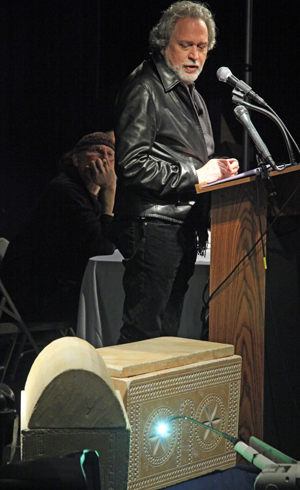A new book called The Jesus Discovery is setting popular imaginations aflame while triggering academic disputes.The work - the top trending topic on Yahoo! this morning - contends that two Jerusalem tombs beneath a condominium complex can be traced to Jesus of Nazareth, his family or his followers.
One tomb, found in 2010 under a patio, "is directly connected to Jesus' first followers, those who knew him personally, and to Jesus himself," according to authors James D. Tabor and Simcha Jacobovici.
Exploring the tomb with a robotic camera, they found two bone boxes, or ossuaries, with an image and an inscription that suggest early Christian ideas about resurrection.
The inscription could be translated as "Divine Jehovah, raise up, raise up."
"The discovery provides the earliest archaeological evidence of faith in Jesus' resurrection from the dead, the first witness to a saying of Jesus that predates even the writing of our New Testament gospels, and the earliest example of Christian art, all found in a sealed tomb dated to the 1st century," according to the book.
In turn, that discovery may have shed new light on a second tomb, discovered in 1980, that lies under a garden just 200 yards away.
"A compelling argument can be made that the Garden tomb is that of Jesus of Nazareth and his family," the authors write. ". . . Both tombs are most likely located on the rural estate of Joseph of Arimathea, the wealthy member of the Sanhedrin who according to all four New Testament gospels took official charge of Jesus' burial."
The publisher's description of the book at amazon.com leaves even less doubt as to what's being claimed: "The new discovery increases the likelihood that the 'Jesus Family Tomb' is, indeed, the real tomb of Jesus of Nazareth."
The book is already the top-selling religious book on Amazon.com.
These conclusions have not exactly generated acceptance, since they seem to rest on interpretations of imagery and artifacts.
In just the first 24 hours, the book has prompted "heated" responses, and such skepticism is understandable, blogs Tabor, chair of the Department of Religious Studies at the University of North Carolina at Charlotte.
"The very notion of 'finding the tomb of Jesus' rightly smacks of cheap sensationalism to most academics - akin to bogus claims of locating the ark of the covenant, the holy grail, pieces of the true cross, or Noah's ark."
Many of the Christian faithful also resist the idea because they believe Jesus ascended bodily to heaven, "precluding the possibility of his earthly remains ever turning up," Tabor wrote this morning at www.jamestabor.com.
Strong dissent is easily found on posts at the blog of the American Schools of Oriental Research (www.asorblog.com), where experts dispute claims that the authors found Christian-related fish imagery.
"I absolutely refute any claim that I concur with the interpretation of any first-century ossuary iconography as depicting Jonah," writes Vanderbilt professor Robin Jensen, who was asked to examine artifacts for a film on the discoveries by National Geographic. "Nor do I believe that 'first-century visual evidence of Christian belief in the resurrection' has been discovered to date."
Co-author Jacobovici is an award-winning filmmaker and journalist.
A so-called fish image might really be a tower, several academics state, including Robert Cargill of the University of Iowa.
Tabor countered in a comment: "You really have to be kidding Robert . . . you really think there is a resemblance . . . and you would need to put the monument upside down? . . . This is really too much."
But Tabor acknowledged on his own blog the discussion has only begun:
"Since even the executive director of ASOR, my friend Andy Vaughn, declared yesterday that the claims of our book had a 'zero percent chance of being correct,' it seems, from my standpoint at least, there is a lot that needs to be said."
